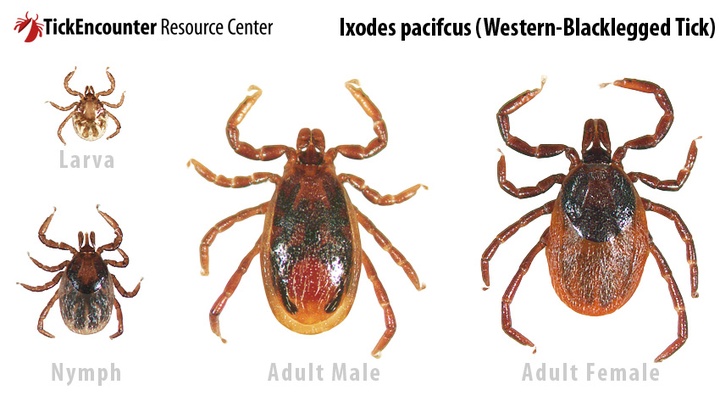
This is the kind that can carry Lyme disease. Gross. | Image source.
From the Humboldt County Department of Health and Human Services:
Tick season is quickly approaching, and the Humboldt County Department of Health & Human Services (DHHS) is reminding people to protect themselves and their animals.
The tiny, spider-like bugs attach themselves onto the skin of people and animals and feed on their blood. While many ticks are not harmful, there are some that transmit disease.
“It is impossible to tell if a tick carries Lyme disease or any other tick-borne disease by looks alone,” said DHHS Environmental Health Director Melissa Martel. “It’s important to educate yourself on tick safety and precautions.”
Only one tick found locally has the bacterium that causes Lyme disease—the Western blacklegged tick.
“As the weather gets warmer and we start to spend more time outdoors, we increase the chances of our exposure to adult ticks and the smaller nymphal stage ticks, which can also carry disease,” Martel said. “If you spend time in brushy, wooded areas or in our beach grasses, it’s important to check yourself thoroughly when you leave. If you find a tick on you, remove it properly and immediately.”
If you find a tick attached to your skin, use fine-tipped tweezers to grasp the tick as close to the surface of the skin as possible. Pull upward with steady, even pressure. Do not jerk or twist it. Make sure the entire tick has been removed, including the head. Once the tick has been removed, clean the area and your hands with rubbing alcohol, an iodine scrub or soap and water.
The Public Health Lab offers free tick identification. After removing a tick, if you want to know what type it is, place it in a sealed container or zip-close bag with a paper towel moistened with water.
If the tick is identified by lab staff as a Western blacklegged tick, they can test it for Borrelia burgdorferi, the bacterium that causes Lyme disease, for a $40 fee.
The Public Health Lab is located at 529 I St. in Eureka. For more information about tick testing, call 707-268-2179.
The Centers for Disease Control and Prevention offers the following tips to stay tick-free this season:
- Avoid wooded and brushy areas with high grass and leaf litter. Ticks are also common locally in our grass beach dunes.
- When out on the trails, stick to the center of trails.
- Use repellents that contains 20 percent or greater DEET, picaridin, or IR3535 directly on to exposed skin. Always follow product label instructions. Parents should apply this product to their children, avoiding hands, eyes and mouth.
- Use products that contain permethrin on clothing. Treat clothing and gear, such as boots, pants, socks and tents with products containing 0.5 percent permethrin. It remains protective through several washings. Pre-treated clothing is available and may be protective longer.
- Remove ticks found on your body immediately.
- Bathe or shower as soon as possible after coming indoors (preferably within two hours) to wash off and more easily find ticks that are crawling on you.
- Conduct a full-body tick check using a hand-held or full-length mirror to view all parts of your body upon return from tick-infested areas. Parents should check their children for ticks under the arms, in and around the ears, inside the belly button, behind the knees, between the legs, around the waist and especially in their hair.
- Examine gear and pets. Ticks can ride into the home on clothing and pets, then attach to a person later, so carefully examine pets, coats and day packs.
CLICK TO MANAGE